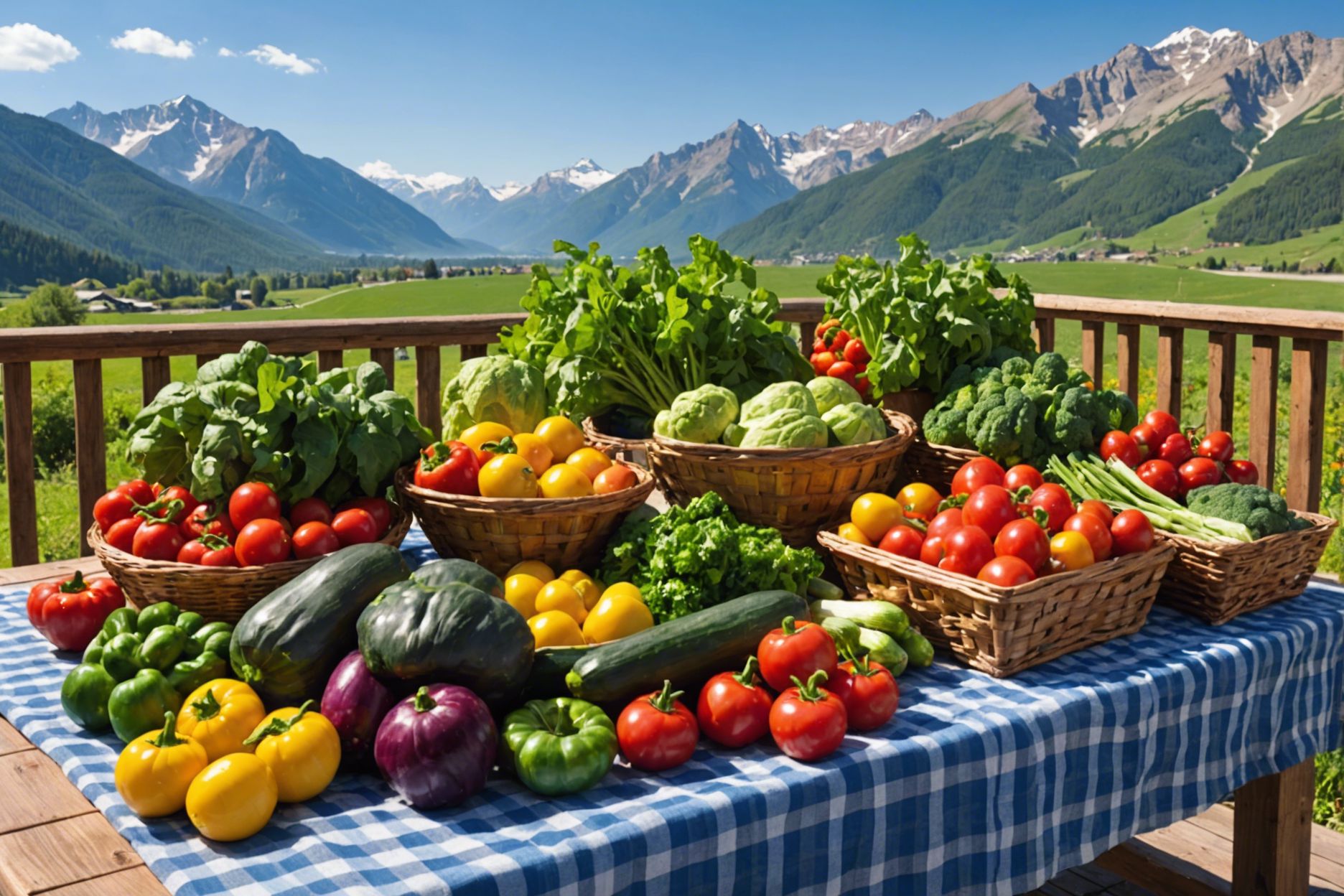Ever wondered why your favourite vegetables taste better at certain times of the year?
Navigating the maze of seasonal produce can be confusing, leaving many to miss out on the peak flavours and nutritional benefits.
In Switzerland, each season brings its own bounty of fresh vegetables, from spring’s cauliflower and cucumber to winter’s colewort and black salsify, offering a varied and sustainable diet.
This blog will guide you through the Swiss vegetable calendar, revealing the best seasonal picks for each part of the year, and why choosing local and seasonal produce is not only great for your palate but also for the planet and local economy.
Understanding the Seasonal Calendar for Swiss Vegetables

Understanding the seasonal calendar for Swiss vegetables is like having a roadmap to the freshest, tastiest, and most sustainable produce available throughout the year. It’s a guide that not only informs us about what vegetables are in season at any given time but also encourages us to make environmentally friendly choices. By aligning our shopping habits with this calendar, we can enjoy vegetables at their peak of flavour and nutritional value, while also supporting local farmers and reducing our carbon footprint.
The significance of the seasonal calendar cannot be overstated. It’s not just about eating healthily; it’s about participating in a cycle that respects the rhythms of nature and the hard work of our local producers. Whether it’s the crisp freshness of spring vegetables or the hearty root vegetables of winter, each season brings its own delights. By choosing seasonal and regional, we’re not only indulging in the best tastes but also contributing to a more sustainable and locally focused food system.
Winter Wonders: Seasonal Vegetables to Enjoy

Winter in Switzerland doesn’t mean a shortage of fresh vegetables. In fact, it’s the season for some of the most nutritious and comforting foods. Root vegetables like carrots and beetroot, along with winter greens such as kale and brussels sprouts, are not only versatile in the kitchen but packed with vitamins to boost our immune system during the colder months.
Cooking with winter vegetables offers endless possibilities, from hearty stews and soups to roasted dishes and warm salads. Root vegetables can be roasted to bring out their natural sweetness, while brussels sprouts and kale can be sautéed with garlic for a quick and healthy side. Don’t forget about red cabbage and leeks, which can add depth and flavour to any winter meal.
Autumn Harvest: Switzerland’s Seasonal Bounty
Autumn in Switzerland is a time of abundance, with a wide range of vegetables reaching their peak. This season is particularly rich in flavours, featuring beetroot, carrots, and a variety of squashes, including the beloved pumpkin. These vegetables not only add a splash of colour to our plates but are also loaded with nutrients.
The autumn harvest offers a great opportunity to experiment in the kitchen. Beetroot can be used in both sweet and savoury dishes, from salads to cakes. Carrots and pumpkin make for delicious soups and pies, perfect for cosy evenings. Preserving some of autumn’s bounty, such as making pickles or jams, can also be a rewarding way to enjoy these flavours year-round.
Summer Selections: Fresh Seasonal Vegetables

Summer brings a bounty of fresh and vibrant vegetables to Switzerland’s markets and gardens. This season is all about courgettes, carrots, and a variety of leafy greens, which are perfect for creating light and healthy meals. Summer is the ideal time to enjoy vegetables raw, in salads, or lightly grilled for a delicious barbecue side.
Utilising summer vegetables in your cooking not only enhances the flavour of your dishes but also maximises their nutritional benefits. Courgettes can be spiralised for a low-carb pasta alternative, while carrots add sweetness and crunch to salads. Don’t forget to throw some vegetables on the grill for an easy and tasty summer meal.
Why Choose Seasonal and Regional Vegetables?
Choosing seasonal and regional vegetables is a wise decision for several reasons. Firstly, it supports your health by providing fresher produce that is likely to contain more nutrients. Vegetables grown and consumed in their proper season have not had to endure long storage periods, which can deplete their vitamin content. This means you’re getting the maximum benefit from what you eat, including essential vitamins and minerals that your body needs to function optimally.
Beyond personal health, opting for seasonal and regional produce benefits the environment and bolsters the local economy. By reducing the need for long-distance transportation, we cut down on CO2 emissions, making a positive impact on the planet. Furthermore, spending your money on local produce ensures that it stays within the community, supporting local farmers and encouraging sustainable agricultural practices. This creates a stronger, more resilient local food system.
The Benefits of Going Local with Your Vegetables
Going local with your vegetables offers significant advantages. Freshness is a key benefit, as local produce often goes from farm to table in a much shorter time frame compared to vegetables that travel long distances. This not only ensures a better taste but also retains more vitamin C and other nutrients, which are crucial for maintaining good health.
Moreover, choosing local vegetables contributes to a reduced carbon footprint. Transportation is a major source of greenhouse gas emissions, so by purchasing vegetables grown close to home, you’re helping to lessen environmental impact. Additionally, supporting local farmers strengthens the regional economy, creating jobs and keeping money within the community. This fosters a sense of connection and appreciation for the people who grow our food.
Spring Into Health: Seasonal Vegetables to Look For

Spring in Switzerland heralds the arrival of a vibrant selection of vegetables, marking a perfect time for a dietary refresh. Among the stars of the season are asparagus and radishes, both known for their crisp textures and fresh flavours. These vegetables not only add a splash of colour to your plate but are packed with nutrients essential for a healthy spring diet.
Incorporating these seasonal vegetables into your meals is not only a treat for your taste buds but also benefits your health in several ways. For example:
- Asparagus is rich in vitamins A, C, and E, and is a great source of fibre.
- Radishes, on the other hand, are low in calories but high in vitamin C, aiding in digestion and boosting the immune system.
Discover Swiss Seasonal Vegetables with INDULGE
INDULGE offers an exceptional opportunity to explore and appreciate the rich diversity of Swiss seasonal vegetables through its curated culinary tours and exclusive dining experiences in Zurich. These tours are not just about tasting; they’re a deep dive into the heart of Swiss gastronomy, where participants can learn about the significance of seasonal produce in Swiss cuisine. By joining an INDULGE tour, you’re signing up for more than just a meal; you’re embarking on a journey that highlights the importance of:
- Eating seasonally for the freshest flavours
- Supporting local farmers and the economy
- Reducing your carbon footprint through local sourcing
Beyond the educational aspect, INDULGE’s tours promise an unforgettable culinary adventure, where every dish served is a celebration of the current season’s bounty. Whether it’s the crisp asparagus of spring, the juicy tomatoes of summer, the hearty squashes of autumn, or the robust root vegetables of winter, INDULGE ensures that participants enjoy the best of Swiss produce at its peak. This approach not only elevates the dining experience but also fosters a deeper connection between the diners and the local food landscape, making every bite a testament to the beauty and richness of Swiss seasonal vegetables.
Frequently Asked Questions
What are the autumn vegetables in Switzerland?
Autumn in Switzerland is abundant with a variety of vegetables, notably including beetroot, carrots, and a range of squashes like pumpkin. These vegetables are not only vibrant and nutrient-rich but also add a splash of colour and flavour to autumnal dishes.
What vegetables grow in Switzerland?
Switzerland grows a diverse range of vegetables throughout the year. This includes, but is not limited to, carrots, beetroot, kale, brussels sprouts, red cabbage, leeks, courgettes, asparagus, and radishes. Each season brings its own selection of fresh produce, ensuring a varied and nutrient-rich diet.
What vegetables are in what season?
In Switzerland, seasonal vegetables vary throughout the year. During winter, root vegetables like carrots and beetroot, along with greens such as kale and brussels sprouts, are prevalent. Autumn features beetroot, carrots, and squashes like pumpkin. Summer is known for courgettes, carrots, and leafy greens, while spring brings asparagus and radishes to the forefront. Each season offers a unique bounty of vegetables.
What is seasonal green vegetables?
Seasonal green vegetables refer to leafy greens that are best eaten during their natural growing season, ensuring optimal freshness, flavour, and nutritional value. In Switzerland, examples include kale and brussels sprouts in winter, and various leafy greens during summer. These vegetables are an integral part of a healthy diet, providing essential vitamins and minerals.








